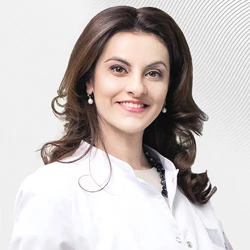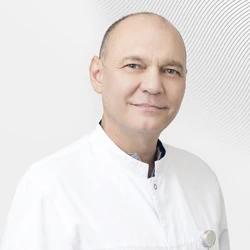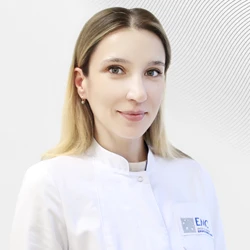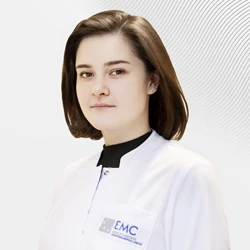Seborrheic dermatitis
Sebum is the secret of sebaceous gland cells — sebocytes. Sebum lipids are located on the surface and in the upper part of the stratum corneum of the epidermis.
The composition of sebum includes:
- Triglycerides - 50%,
- Wax esters - 20%,
- Squalene - 10%,
- Free fatty acids - 5%,
- Cholesterol and cholesterol esters - 5%,
- Sterols - 1%,
- Other components - 9%
Many people face the problem of oily scalp and dandruff. The hair sticks together, soaked in sebum, and looks untidy. Scales or gray-yellow crusts may form in the hair, or dandruff in another way. This is due to increased secretion of sebaceous glands and desquamation of the epidermis cells of the scalp. Dandruff is considered a mild degree of seborrheic dermatitis. In more severe stages, erythematous spots and plaques appear, covered with flaky or greasy scales.
The disease can spread beyond the scalp ("seborrheic crown"), affecting the area behind the ear, the skin of the face, chest, back, and even the ear canals. Itching and burning may occur in the affected areas. Changes in the scalp often adversely affect the condition of the hair. They become thin, brittle, and dull. Seborrheic dermatitis is often accompanied by increased hair loss.
Seborrheic dermatitis is considered a severe form of dermatosis. The age at which the risk of developing the disease increases is 15-25 years and after 40. Men are more prone to developing seborrhea, as a rule, their symptoms are more active.
The disease usually begins in adolescence, this is due to an increase in the activity of the sebaceous glands and an increase in the concentration of testosterone in the blood. Triggers that provoke the disease also include increased sebum production, hormonal disruptions, immunosuppression, gastrointestinal pathologies and increased emotional stress. Seborrheic dermatitis is often diagnosed in patients with the human immunodeficiency virus. The disease often progresses in winter due to insufficient humidification of the indoor air.
It has been scientifically proven that the development of seborrheic dermatitis is influenced by the activation of fungi of the genus Malassezia. They are found in the composition of the microflora of the skin in almost 90% of the population. Among the fungi of the genus Malassezia, the occurrence of seborrheic dermatitis is most often influenced by the species Malassezia globosa, Malassezia restricta and Malassezia furfur. They affect the middle and superficial parts of the stratum corneum of the epidermis and hair follicles. A change in the composition of sebum (a decrease in the ratio of squalene/triglycerides) contributes to the excessive development of yeast-like fungi and their transition into a pathogenic mycellar form.
With seborrheic dermatitis, the barrier function of the skin is disrupted. The characteristic layered structure is replaced by a broader unstructured lipid substance. Lipids of sebaceous secretions change under the action of a substance secreted by Malassezia, with the formation of free fatty acids. They, in turn, are the basis for lipid peroxidation products, which are the main causes of inflammation.
A pronounced cosmetic defect and itching, in addition to physical discomfort, cause emotional distress in patients, significantly reducing the quality of life. Social maladaptation is formed, difficulties appear in professional, family life, intimate relationships, depression and anxiety disorders may develop. Therefore, timely and proper treatment of the disease is very important
Seborrheic dermatitis on the head and sebaceous glands
The secret of the sebaceous glands is a mixture of lipids, or sebum. Sebum is necessary for the normal functioning of the skin: to moisturize it, maintain elasticity, and create a protective barrier.
Sebaceous glands are located unevenly on the skin, there can be from 4 to 380 ducts per 1 cm2. The largest number of sebaceous glands is located in the so-called "seborrheic zones": on the skin of the face and scalp, on the back, neck, chest, shoulders, forearms. There are no sebaceous glands on the skin of the soles and palms.
Most sebaceous gland ducts open at the mouths of hair follicles.
The size of the glands and the amount of lipid secretions released depend on the functioning of the endocrine, nervous, reproductive systems and age. In children, the sebaceous glands secrete little secretions. By puberty, their work increases dramatically, but as they get older, their activity decreases. In adult men, sebum is constantly secreted in about the same amount, in women this process is often associated with the menstrual cycle. In old age, the amount of secreted secretions decreases.
Types of seborrheic dermatitis
Each subspecies of seborrhea has its own symptoms and features of the course.
The main subspecies of seborrheic dermatitis:
-
dry
-
bold
-
mixed
In dry seborrheic dermatitis, dandruff layers overlap each other, forming crusts. Distinctive features: dryness and peeling, cracks on the skin, brittle hair, changes in its structure, light red spots on the occipital part of the head, severe itching.
In the absence of treatment, the sebaceous glands become activated and hair loss begins. Dry dandruff easily crumbles, hair follicles die, which leads to alopecia. The disease progresses, affecting the skin on the head and body.
With oily seborrheic dermatitis, excessive secretion with a disturbed composition occurs, thereby reducing the protective functions of the skin and creating ideal conditions for infection. Distinctive symptoms: red, sometimes yellowish, spots on the skin, the skin becomes shiny, greasy, prone to inflammation, severe itching is present, a yellow coating of dandruff appears on the hair. The first to be affected are the hair and facial skin, yellow scales form, which easily lag behind the skin.
If left untreated, baldness may occur after a few years.
Forms of oily seborrhea:
Thick shape. The skin becomes brownish-gray in color, elasticity decreases. When pressing on the blocked duct of the gland, a fatty mass is released - a horny plug. At the sites of opening of sebaceous gland cysts, a curd mass is released, which subsequently scars.
Liquid form. It is characterized by the presence of an "orange peel", enlarged pores, and an excessive amount of sebum, which is several times higher than normal. Hair quickly acquires a greasy sheen, yellow crusts of scales cover the skin and sometimes cause itching.
With mixed seborrheic dermatitis, symptoms of dry and oily subspecies are noted simultaneously. Often, symptoms of dry seborrhea appear on the face, and oily on the hair. In the absence of treatment, alopecia occurs. New hair grows more slowly, gets thinner faster, and is replaced by fluff.
Dandruff is also considered one of the types of seborrheic dermatitis. Dandruff affects more than half of the world's population, but it is most often found in women. Dandruff affects the scalp, dandruff particles easily peel off, which causes significant emotional discomfort in a person. White, yellow or grayish-silver dandruff scales are distinguished by color.
Symptoms of seborrheic dermatitis
-
Red, sometimes with a yellowish tinge, flaky spots and nodules. They may become covered with yellow crusts, wetness, cracks;
-
The rashes are usually ring-shaped with clear boundaries.
-
Symptoms are localized on the scalp, facial skin (nasolabial triangle, nose wings, cheeks, eyebrows, forehead, chin), in the xiphoid process of the sternum, etc.;
-
Intense, often painful itching;
-
Even the cleanest people can look untidy, "greasy" because of the disease;
-
With significant damage to the scalp, hair may fall out, and the affected area may extend beyond the hairline (the so-called seborrheic crown, or in children, seborrheic bonnet);
Causes of seborrheic dermatitis
The reason is fungi of the genus Malassezia. They can cause dandruff and seborrheic dermatitis. Peeling is the most common sign of skin and hair damage caused by this fungus. Peeling can be of varying severity, from flakes that do not cause concern to severe skin lesions with itching. Usually, patients do not consult a doctor, preferring to use simple dandruff shampoos. The wrong choice of care can worsen the situation, when, on the contrary, more favorable conditions are created for the reproduction of the fungus and the progression of the disease.
Factors contributing to the development of seborrheic dermatitis:
-
endocrinological disorders: diabetes mellitus, hormonal disruptions, impaired glucose tolerance;
-
gastrointestinal diseases;
-
hereditary predisposition;
-
excessive sweating;
-
abnormalities in the central nervous system (Parkinson's disease, paralysis, polyneuropathy, etc.);
-
decreased immunity (with a deficiency of vitamins and minerals, skin functions decrease and conditions are created for the development of pathogenic flora, fungus);
-
stress.
Seborrheic dermatitis often develops and occurs in severe forms in patients with HIV and AIDS.
Diagnosis of seborrheic dermatitis
The diagnostic search begins with a detailed consultation, visual examination and medical history collection.
Research allows to clarify the diagnosis and differentiate seborrheic dermatitis from other dermatological diseases.:
-
microscopy;
-
dermatoscopy;
-
laboratory blood tests (general parameters, hormone levels);
-
spectral survey;
-
in some cases, histological examination of a skin biopsy.
Seborrhea should be differentiated from psoriasis, allergic dermatitis, atopic dermatitis, plaque parapsoriasis, rosacea, demodicosis.
Rashes with psoriasis are usually bright pink or rich red in color, significantly thickened, with pronounced peeling of gray-white color. There may be rashes on different areas of the skin, nail plates are affected.
In atopic dermatitis, the main criteria are the results of allergy tests and a high level of IgE immunoglobulin.
During differential diagnosis with fungal diseases, microscopic examination is performed to identify the elements of the fungus.
If allergic dermatitis is suspected, skin tests are performed.
Comprehensive diagnosis is necessary to prescribe personalized and most effective therapy in each case.
Treatment of seborrheic dermatitis
Assigned for the purpose of achieving:
- regression of rashes
- elimination of fungal infection
- prevention of secondary infection
- eliminate itching.
The choice of treatment tactics depends on the severity of the symptoms, the duration of the disease, and the results of previous treatment.
Seborrheic dermatitis requires long-term treatment using systemic and topical therapy. For external use, products with anti–inflammatory, antipruritic, antifungal, and in case of secondary infection, antibacterial and antiseptic effects are used.
In case of intense itching, which significantly impairs the patient's quality of life, the use of antihistamines is recommended.
Even today, despite the rapid development of technology, treatment is still difficult because the disease is genetically determined and prone to relapse even with proper care and treatment. Factors that provoke it: hard water, cold or hot climate, frequent flights, stress, dry air, diet disorders.
In modern dermatology, much attention is paid to immune therapy, which gradually pushes aside hormonal drugs.
The main thing is a competent doctor and self-discipline of the patient.
Drug therapy
External treatment:
Topical glucocorticosteroid drugs
Glucocorticosteroid drugs with moderate or high degree of anti-inflammatory activity are used for severe inflammation with hyperemia and weeping. With a decrease in the severity of symptoms, glucocorticosteroid drugs with mild or moderate anti-inflammatory activity are used.
Anti-inflammatory drugs
Topical antifungal drugs
If a secondary infection is added, ointments containing antibacterial drugs are used.
Systemic treatment
With severe itching, antihistamines are prescribed
Non-drug therapy
In some cases, phototherapy is used.
Therapy results
-
improvement of the patient's general condition;
-
reduction of inflammation;
-
cessation of exudation and itching.
Experts do not recommend self-medication, and if you choose the wrong medications, your condition may worsen.
Disease prevention
During the remission of seborrheic dermatitis, it is recommended to use shampoos with antimycotics, as well as zinc pyrithione, tar, selenium disulfide. The optimal combination is a combination of several active substances that a doctor should prescribe. You can
apply shampoos and pastes with selenium disulfide. There is practically no fungal resistance to this component.
It is recommended to follow a diet and adjust your lifestyle. It is not recommended to wear clothes made of wool and synthetic fabrics. Clothes should be carefully ironed daily. The same recommendations apply to hats. You can not use other people's hats, even for a short time, because the fungus, which causes only slight peeling in one person, can provoke an exacerbation in a person prone to seborrheic dermatitis. If you notice a connection between exacerbations and psychoemotional stress, you should consider consulting a psychotherapist or psychiatrist.
Unfortunately, if there is a tendency to develop seborrheic dermatitis, a complete cure is difficult to achieve. However, proper treatment and prevention in the relapse-free period make it possible to keep the disease in remission, and make the course of exacerbations less severe.
You can make an appointment for a consultation with the specialists of the EMC Clinic of Dermatovenerology and Allergology-immunology by phone +7 (495) 933 66 55 or online by filling out form. Remote consultations with the attending physician are possible (in case a second consultation or correction of the therapy is required).
Why the EMC
The first and only clinic in Russia, created in the image of the world's leading clinics
EMC is a multidisciplinary center offering patients a high level of medical services and a personalized approach
Worldwide recognition and awards
 Learn more
Learn more
Worldwide recognition and awards
 Certificates and licenses
Certificates and licenses
Make an appointment for a consultation
Specify your contacts and we will contact you to clarify the details
Reviews
and new products of the EMC


.webp)
.webp)
.webp)







